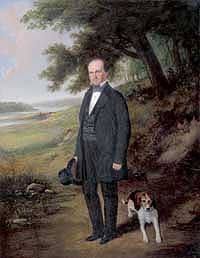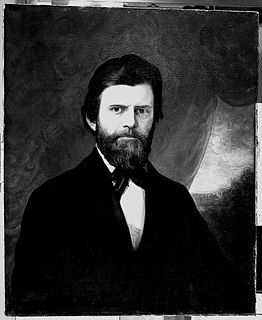Related Research Articles

The Northwest Ordinance, enacted July 13, 1787, was an organic act of the Congress of the Confederation of the United States. It created the Northwest Territory, the new nation's first organized incorporated territory, from lands beyond the Appalachian Mountains, between British North America and the Great Lakes to the north and the Ohio River to the south. The upper Mississippi River formed the territory's western boundary. Pennsylvania was the eastern boundary.

The Territory of Michigan was an organized incorporated territory of the United States that existed from June 30, 1805, until January 26, 1837, when the final extent of the territory was admitted to the Union as the State of Michigan. Detroit was the territorial capital.

The Territory of Wisconsin was an organized incorporated territory of the United States that existed from July 3, 1836, until May 29, 1848, when an eastern portion of the territory was admitted to the Union as the State of Wisconsin. Belmont was initially chosen as the capital of the territory. In 1837, the territorial legislature met in Burlington, just north of the Skunk River on the Mississippi, which became part of the Iowa Territory in 1838. In that year, 1838, the territorial capital of Wisconsin was moved to Madison.

The Indiana Territory was created by a congressional act that President John Adams signed into law on May 7, 1800, to form an organized incorporated territory of the United States that existed from July 4, 1800, to December 11, 1816, when the remaining southeastern portion of the territory was admitted to the Union as the state of Indiana. The territory originally contained approximately 259,824 square miles (672,940 km2) of land, but its size was decreased when it was subdivided to create the Michigan Territory (1805) and the Illinois Territory (1809). The Indiana Territory was the first new territory created from lands of the Northwest Territory, which had been organized under the terms of the Northwest Ordinance of 1787. The territorial capital was the settlement around the old French fort of Vincennes on the Wabash River, until transferred to Corydon near the Ohio River in 1813.

John Scott Horner was a U.S. politician, Secretary and acting Governor of Michigan Territory, 1835–1836 and Secretary of Wisconsin Territory, 1836–1837.

James Duane Doty was a land speculator and politician in the United States who played an important role in the development of Wisconsin and Utah Territory.

Morgan Lewis Martin was a delegate to the United States Congress from Wisconsin Territory from 1845 to 1847. He also served as a member of the Wisconsin State Senate and Wisconsin State Assembly, and served as a County Judge in Brown County, Wisconsin.

The 1848 Wisconsin gubernatorial election was held on May 8, 1848. This was the election for the first Governor of Wisconsin, which became a U.S. state that year, as it was held concurrent with a public referendum to ratify the Constitution of Wisconsin.

The 1st Michigan Legislature, consisting of the Michigan Senate and the Michigan House of Representatives, met in Detroit in three sessions between November 2, 1835, and July 26, 1836, during the first year of Stevens T. Mason's governorship of the (prospective) state.

The Sixth Michigan Territorial Council was a meeting of the legislative body governing Michigan Territory, known formally as the Legislative Council of the Territory of Michigan. The council met in Detroit in two regular sessions, one extra session, and one special session between January 7, 1834, and August 25, 1835, during the terms of George B. Porter and Stevens T. Mason as territorial governors.
The Seventh Michigan Territorial Council, also known as the Rump Council, was a meeting of the legislative body governing Michigan Territory in January 1836, during the term of Acting Governor John S. Horner. At the time, part of Michigan Territory was awaiting admission to the union as the state of Michigan and had already seated its new state legislature. This was the final session of the council and consisted only of members from the "rump territory"—the remaining counties that formed the new Wisconsin Territory later that year.

The Fifth Michigan Territorial Council was a meeting of the legislative body governing Michigan Territory, known formally as the Legislative Council of the Territory of Michigan. The council met in Detroit in two regular sessions between May 1, 1832, and April 23, 1833, during the term of George B. Porter as territorial governor.
The Fourth Michigan Territorial Council was a meeting of the legislative body governing Michigan Territory, known formally as the Legislative Council of the Territory of Michigan. The council met in Detroit in two regular sessions between May 11, 1830, and March 4, 1831, during the terms of Lewis Cass and George B. Porter as territorial governor.
The Second Michigan Territorial Council was a meeting of the legislative body governing Michigan Territory, known formally as the Legislative Council of the Territory of Michigan. The council met in Detroit in two regular sessions between November 2, 1826, and April 13, 1827, during the term of Lewis Cass as territorial governor.
The First Michigan Territorial Council was a meeting of the legislative body governing Michigan Territory, known formally as the Legislative Council of the Territory of Michigan. The council met in Detroit in two regular sessions between June 7, 1824, and April 21, 1825, during the term of Lewis Cass as territorial governor.
William Henry Puthuff, also spelled Puthoff, was an American soldier, businessman, and politician who served in the War of 1812 and occupied a number of government positions in the Territory of Michigan. In his role as Indian agent at Michilimackinac, he engaged in a multi-year conflict with John Jacob Astor and his American Fur Company. He was a member of the First Michigan Territorial Council and died while attending its first session.
The 1823 Michigan Territorial Council election was held in the Territory of Michigan to elect the members of the territory's newly-formed legislative council.
The 1818 Michigan Territory general assembly referendum was held in the Territory of Michigan to determine whether a majority of the territory's freeholders favored the creation of a general legislative assembly to replace the system of governors and judges in effect at the time, as provided for by the Northwest Ordinance. The election was called by Territorial Governor Lewis Cass, and results showed a majority opposed changing the system of government.
References
- "A Bill to Enable the People of Michigan to Form a Constitution and State Government", Democratic Free Press, Detroit, 4 (36), p. 2, December 31, 1834, retrieved 2019-01-01
- "Act of March 3, 1823: To amend the ordinance and acts of Congress for the government of the territory of Michigan, and for other purposes" (PDF), U.S. Statutes at Large, 3, p. 769, 1823, retrieved 2019-09-30
- Dunbar, Willis F.; May, George S. (1995), Michigan: A History of the Wolverine State, Grand Rapids: Eerdmans, retrieved 2019-10-01
- Finkelman, Paul; Hershock, Martin J.; Taylor, Clifford W. (2006), The History of Michigan Law, Ohio University Press, retrieved 2019-10-01
- Gilpin, Alec (2002), The Territory of Michigan (1805-1837), Michigan State University Press, retrieved 2019-10-01
- Michigan Manual (1907–1908 ed.), Lansing: Wynkoop Hallenbeck Crawford, 1907, retrieved 2019-10-01
- Schafer, Jack, ed. (1920), The Rump Council, The State Historical Society of Wisconsin, retrieved 2019-10-01
- "Sixth Legislative Council", Democratic Free Press, Detroit, 5 (19), p. 2, September 2, 1835, retrieved 2019-01-01
- Utley, Henry M.; Cutcheon, Byron M. (1906), Burton, Clarence M. (ed.), Michigan, as a Province, Territory, and State, the Twenty-Sixth Member of the Federal Union, 2, Publishing Society of Michigan, hdl: 2027/mdp.35112104739232 , retrieved 2019-09-30